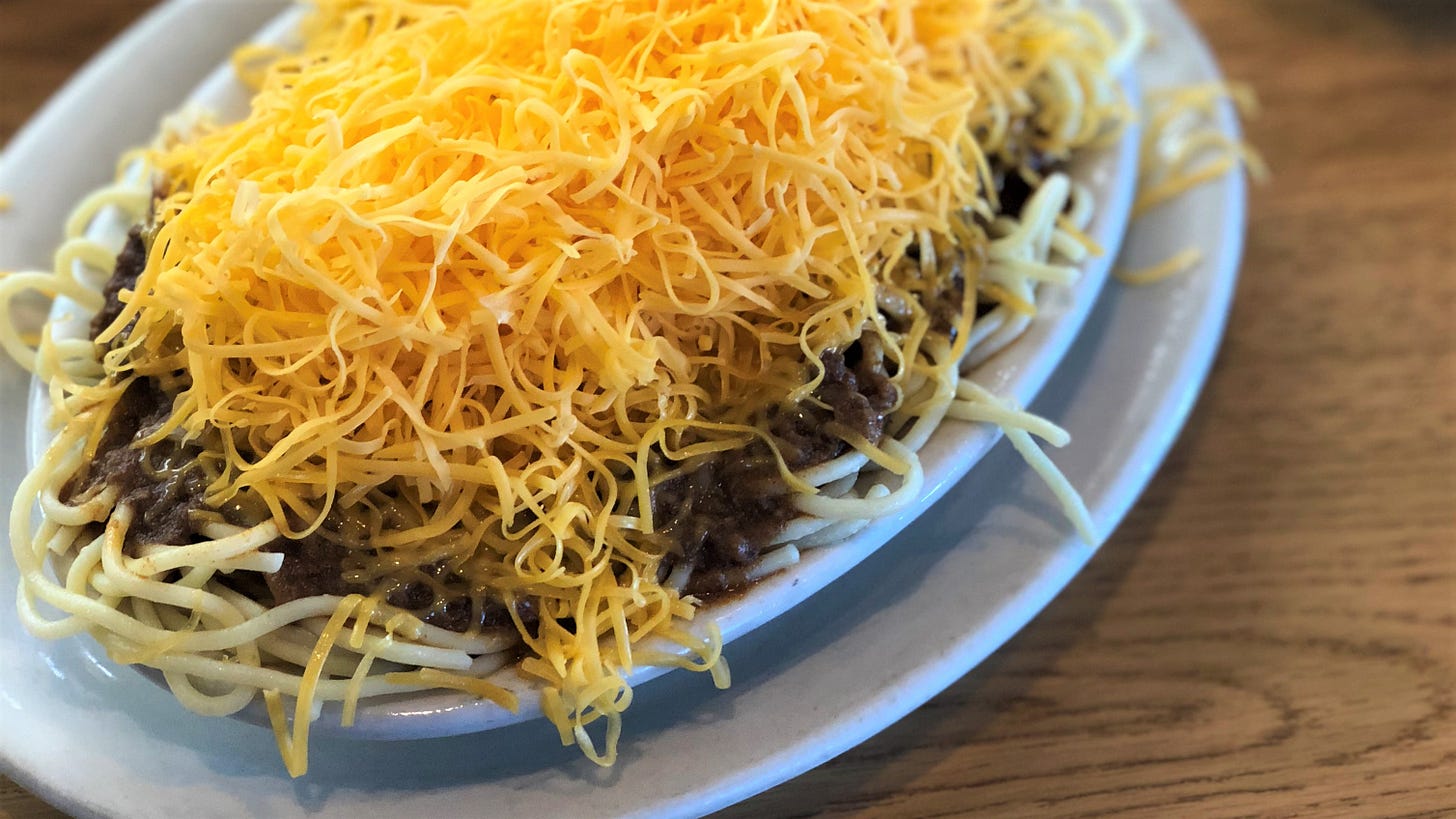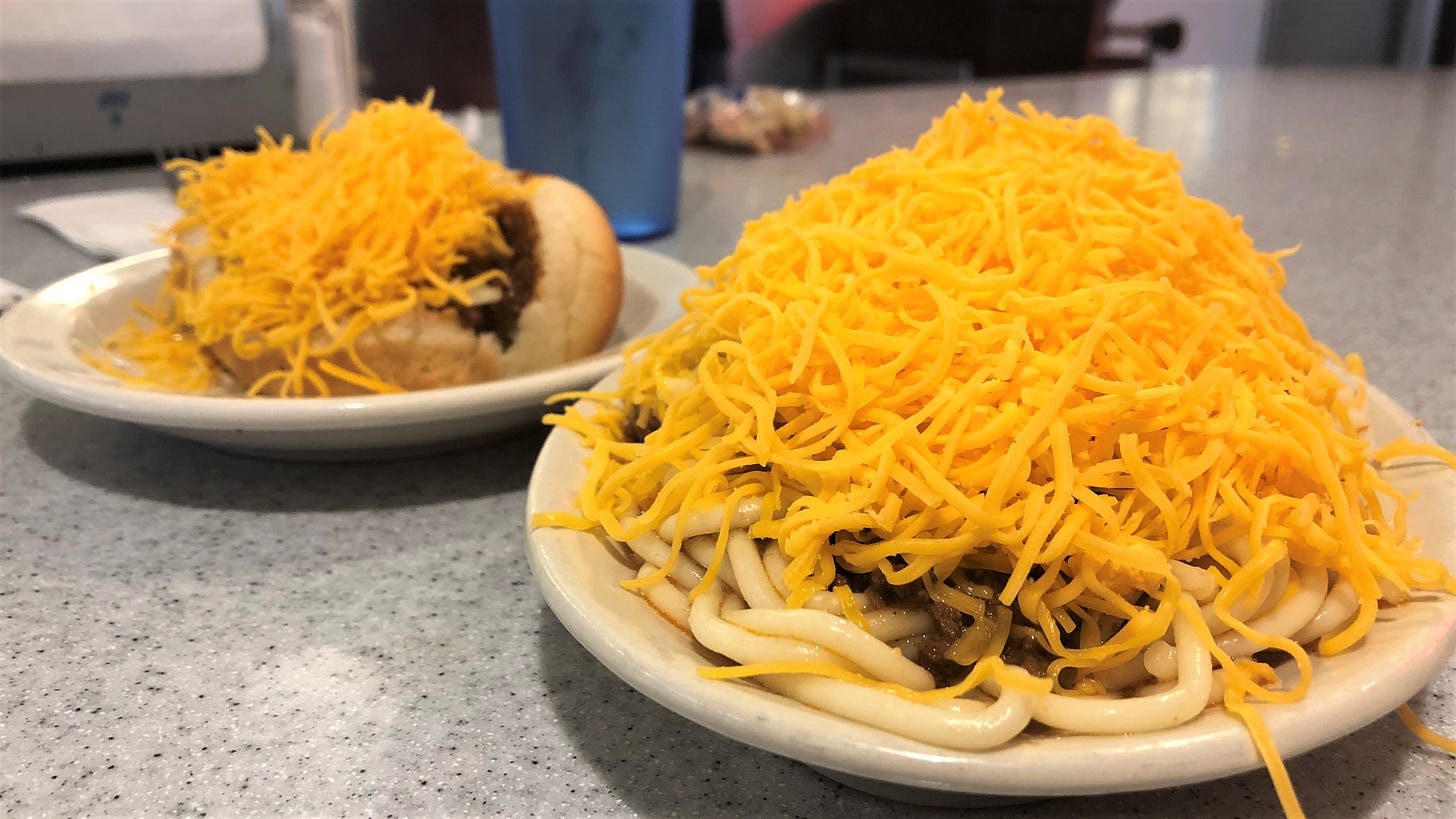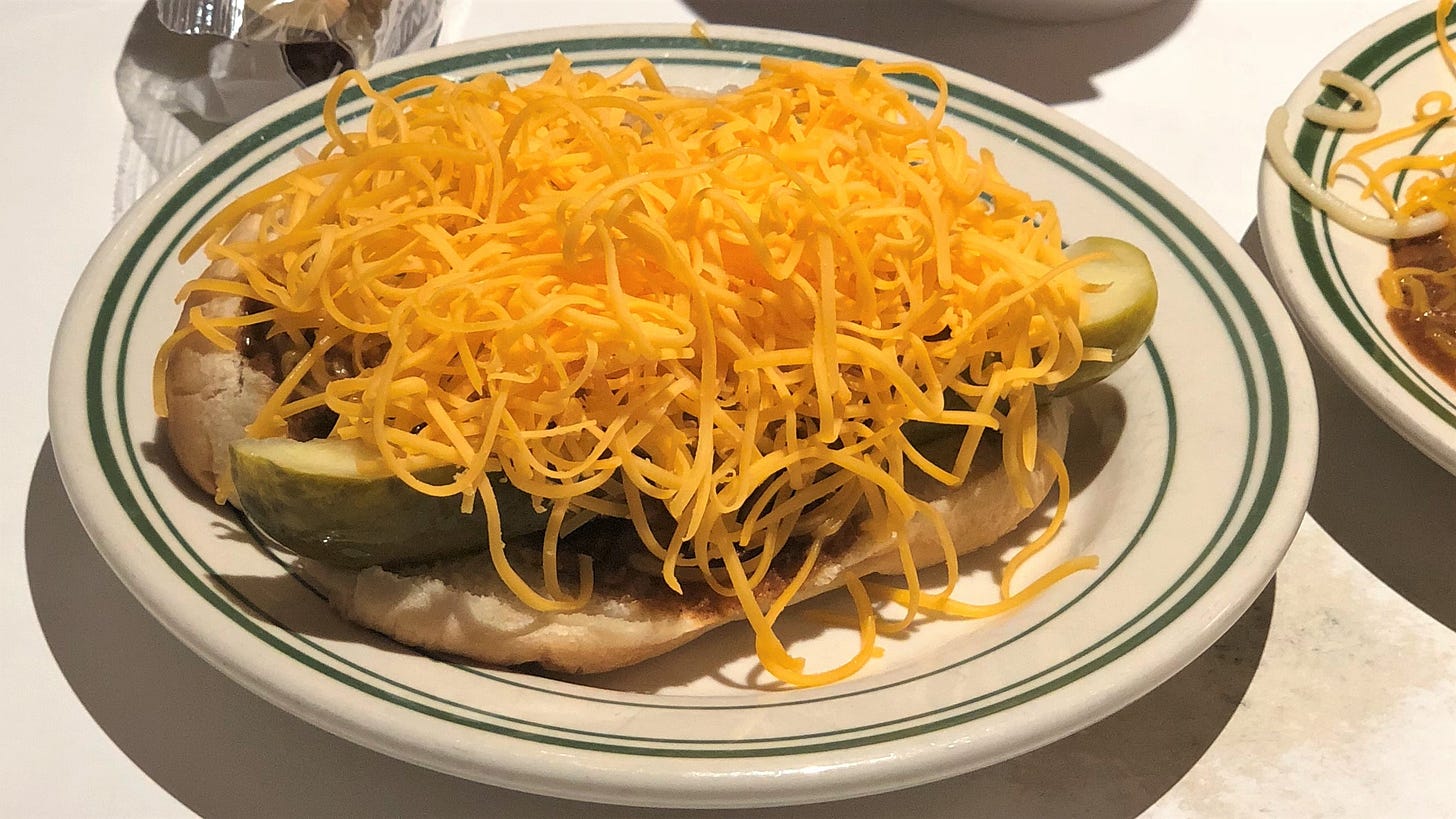The way I see it, most people just don’t understand Cincinnati chili, a polarizing dish so popular in its hometown—which is also mine—that it supports some 250 parlors and two mid-sized regional chains, Skyline and Gold Star.
Those of us who grew up in the Queen City are used to rolling our eyes at over-the-top opinions from out-of-towners like Mets announcer Gary Cohen, who called our chili “disgusting” in a rant that went viral last summer, and Deadspin writer Albert Burneko, who named it “the worst regional foodstuff in America or anywhere else,” describing it as “a horrifying diarrhea sludge,” back in 2013.
It’s really just pasta, a richly seasoned meat sauce, and cheese, plus a couple of optional (and totally inoffensive) toppings: onions and beans. Most of us sprinkle on oyster crackers and a thin, vinegary hot sauce for crunch and zing, respectively. What’s not to like? It’s like a lighter chili mac with better flavor.
My guess: When people who are already skeptical of Midwestern cuisine hear that cooks in Ohio are putting chocolate—not really true, by the way—and cinnamon in a thin, sauce-like “chili,” serving it over spaghetti, and topping it with fistfuls of cheese, they must assume that it’s some kind of misguided midcentury Betty Crocker special. I get that. They don’t know that it’s actually a lively, Mediterranean-spiced take on traditional Greek saltsa kima, introduced to the Midwest by the Macedonian Kiradjieff brothers in the 1920s.
No one tells the true story better than Dann Woellert, a Cincinnati culinary historian and the author of “The Authentic History of Cincinnati Chili.” With the Bengals heading to the Super Bowl for the first time since the late ’80s, bringing national attention to Cincinnati and its traditions, I asked him to help us set the record straight about the most controversial regional dish in America.
Q: What are the fundamentals of Cincinnati chili?
Well, the spices set it apart. Recipes typically have between twelve and eighteen. The required spices are the ones you might find in a baharat* blend. Cincinnati chili always has cinnamon. It’s chili, so it also has to include chile peppers of some sort. But there’s no chocolate. None. Ever. That’s my biggest pet peeve.
*Note: The term baharat—which means “spices” in Arabic—refers to a family of Middle Eastern spice blends that often include allspice, bay leaves, cardamom, cinnamon, cloves, coriander, cumin, nutmeg, and black or white pepper, among other ingredients.
Q: So why do so many people think there’s chocolate in the recipe?
Years ago, a Cincinnati food writer thought she had figured out Skyline Chili’s secret recipe. She printed her version in the Cincinnati Enquirer, and it included chocolate. Since then, as far as I can tell, everyone has been saying that there’s chocolate in Cincinnati chili.
That was the first question I asked every chili parlor owner who I interviewed for the book: “Is there chocolate in your chili recipe?” Almost all of them laughed at me. And all of them said, “No way.”
Nick Sarakatsannis of Dixie Chili had the most thoughtful explanation. He said, first of all, chocolate is a mild flavor, and you would hardly taste it under the ginger, cinnamon, cardamom, and all those powerful spices. His theory was that the reporter tasted chocolate in Skyline’s chili because they use red wine vinegar instead of apple cider vinegar, which most chili parlors use. Maybe that gave her a tannic, chocolate-like note.
Q: What else do people get wrong about Cincinnati chili?
They want it to be Texas chili, and they get upset that it isn’t. We never claimed that it was Texas chili. It’s Greek chili. Chili is about as diverse a food group as anything else categorized under one word. The original chili that came up from Mexico—that became Texas chile con carne—was just stewed meat and chiles. It was as simple as that. As soon as people started adding beans and other ingredients, they expanded the definition. When people say that Cincinnati chili isn't chili in the Texas sense, they’re comparing apples and oranges.
Q: What do only Cincinnatians know about eating Cincinnati chili?
Of course, all of us in Cincinnati know that you don’t twirl your noodles, like linguine. You cut, so you’re guaranteed to get cheese, chili, and pasta in each bite.
You have to have hot sauce and you have to have crackers. The oyster crackers at Cincinnati chili parlors have plenty of room inside, so you can pierce them and sprinkle hot sauce in for a traditional “cracker bomb.” They’re distinct from the dense, starchy crackers that you’d put in an Eastern Shore seafood chowder.
People in my parents’ generation would order upside-down three-ways: cheese on the bottom, topped with chili and then noodles. They’d get “juicy” three-ways—served extra-soupy, which is ridiculous. My mom would get a “dry” three-way, which meant they’d drain the chili for a meatier texture. Anyone who still has special requests like that, they’re totally old-school. Their pictures should be up on the wall.
Q: Is anything about our chili unique to Cincinnati? In other words, is there any reason it couldn’t have come from a Greek diner in New York or Boston?
Originally, Cincinnati chili was just chili spaghetti. It was based on the Greek saltsa kima, which is meat sauce on pasta. It was in Cincinnati that a German customer, probably, in the 1930s asked, Can you put cheese on this? There are a lot of dairy-loving Germans in Cincinnati. So I like to think of Cincinnati chili as fusion food, bringing together our German and Greek immigrant traditions.
Q: How do you eat your chili?
I’m a four-way, onion* guy.
*A quick ordering primer: a three-way is spaghetti, chili, and cheese. A four-way gets beans or chopped onions. A five-way takes you all the way… with just a couple of exceptions, mentioned below.
Q: Where would you send a friend for the perfect plate of Cincinnati chili?
Because just about everyone knows Skyline and Gold Star, I would focus on some of my favorite indie parlors. The first would be Gourmet Chili in Newport, Kentucky. Next, Chili Time in St. Bernard.
Then, I’d choose one of Dixie Chili’s locations in Northern Kentucky. People don’t realize that Dixie is one of the oldest chili parlors in town—much older than Skyline, which opened in 1949, and Gold Star, which opened in 1965. The first true Cincinnati chili parlor, Empress, which is still hanging on with one location, opened in 1922, and Dixie opened just seven years later, in 1929. Dixie’s founder, Nick Sarakatsannis, actually moved across the river to Kentucky so that he wouldn’t be competing with his former employers at Empress.
Q: What are some of your favorite twists on tradition?
I tried one of them within the past year or so, at Tuba Baking Co. in Covington, Kentucky. During the pandemic, they came up with some German specials for takeout. One was a vegan lentil Cincinnati chili three-way over spaetzle, topped with white cheddar cheese. That rocked my world. It was one of the best versions of a three-way I’ve ever had. I always thought Cincinnati chili would be good over spaetzle, and it was everything I wanted it to be and then some.
On the traditional side, Dixie Chili sells an “Alligator” coney—with a pickle spear in the bun. Then, there are two parlors in town with six-ways. Dixie has a six-way with cheese, onions, beans, and chopped garlic over the top. Blue Ash has a six-way with fresh or fried jalapenos.
Q: Why do so many people love to hate our chili, anyway?
If you ask me, they hate that their cities don’t have dishes that are so loved. It’s all about the love. We love it so much that we don't care what people say about it. We will defend it to our dying day. So, I say it's really chili envy. Not hate, envy.
Q: Do you have any tips for someone trying to make Cincinnati chili at home for the first time?
You never brown the meat. You’ve got to boil it. If you brown the meat, like you would in just about any other situation, it’s not going to taste right. It’ll taste too browned, too beefy. There are so many spices in our chili that you don’t want a big, beefy flavor. And the consistency will be off. You want it to be the consistency of a thin, almost homogenous sauce, not a pebbly cafeteria chili.
And once again, don’t use chocolate. Eat your chocolate by itself. Enjoy it. Keep it out of your chili.
If you’re looking for an authentic game-day recipe, try the one in Dann’s book—conveniently available in digital form for those of you who need it right now. Cincinnati chili is an easy make-ahead meal, though you should cook the spaghetti and shred the cheese as close to serving time as possible.
Further reading: The Takeout’s “Cincinnati chili is really just Greek bolognese,” a thoughtful explainer from Cincinnati Enquirer food writer (and Midwesterner contributor) Keith Pandolfi.







